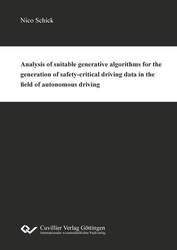| Departments | |
|---|---|
| Book Series (96) |
1378
|
| Nachhaltigkeit |
3
|
| Gesundheitswesen |
1
|
| Humanities |
2365
|
| Natural Sciences |
5406
|
| Mathematics | 229 |
| Informatics | 319 |
| Physics | 980 |
| Chemistry | 1363 |
| Geosciences | 131 |
| Human medicine | 243 |
| Stomatology | 10 |
| Veterinary medicine | 108 |
| Pharmacy | 147 |
| Biology | 835 |
| Biochemistry, molecular biology, gene technology | 121 |
| Biophysics | 25 |
| Domestic and nutritional science | 45 |
| Agricultural science | 1004 |
| Forest science | 201 |
| Horticultural science | 20 |
| Environmental research, ecology and landscape conservation | 148 |
| Engineering |
1793
|
| Common |
98
|
|
Leitlinien Unfallchirurgie
5. Auflage bestellen |
|
Advanced Search
Analysis of suitable generative algorithms for the generation of safety-critical driving data in the field of autonomous driving (English shop)
Nico Schick (Author)Preview
Approximately 3700 people die in traffic accidents each day. The most frequent cause of accidents is human error. Autonomous driving can significantly reduce the number of traffic accidents. To prepare autonomous vehicles for road traffic, the software and system components must be thoroughly validated and tested. However, due to their criticality, there is only a limited amount of data for safety-critical driving scenarios. Such driving scenarios can be represented in the form of time series. These represent the corresponding kinematic vehicle movements by including vectors of time, position coordinates, velocities, and accelerations. There are several ways to provide such data. For example, this can be done in the form of a kinematic model. Alternatively, methods of artificial intelligence or machine learning can be used. These are already being widely used in the development of autonomous vehicles. For example, generative algorithms can be used to generate safety-critical driving data. A novel taxonomy for the generation of time series and suitable generative algorithms will be described in this paper. In addition, a generative algorithm will be recommended and used to demonstrate the generation of time series associated with a typical example of a driving-critical scenario.
| ISBN-13 (Hard Copy) | 9783736974531 |
| ISBN-13 (eBook) | 9783736964532 |
| Final Book Format | A5 |
| Language | English |
| Page Number | 30 |
| Lamination of Cover | matt |
| Edition | 1. |
| Publication Place | Göttingen |
| Publication Date | 2021-06-21 |
| General Categorization | Non-Fiction |
| Departments |
Informatics
|
| Keywords | artificial intelligence, machine learning, mobility, autonomous driving, autonomous car, safety, safety-critical, safety-critical driving, safety-critical driving scenario, safety-critical driving scene, safety-critical driving maneuver, time series, time series data, vehicle data, criticality, kinematic, kinematic model, taxonomy, probability distribution, unsupervised learning, supervised learning, generative algorithm, Generative Adversarial Network, GAN, Restricted Boltzmann Machine, RBM, Recurrent Neural Network, RNN, Conditional Restricted Boltzmann Machine, CRBM, Factored Conditional Restricted Boltzmann Machine, FCRBM, Recurrent Temporal Restricted Boltzmann Machine, RTRBM, Variational-Autoencoder Generative Adversarial Network, VAE-GAN, Recurrent-Conditional Generative Adversarial Network, RCGAN, Time-Series Generative Adversarial Network, TimeGAN, Künstliche Intelligenz, Maschinelles Lernen, Mobilität, Autonomes Fahren, autonomes Auto, Sicherheit, sicherheitskritisches Fahren, sicherheitskritisches Fahrszenario, sicherheitskritische Fahrszene, sicherheitskritisches Fahrmanöver, Zeitreihe, Zeitreihendaten, Fahrzeugdaten, Kritikalität, Kinematik, kinematisches Modell, Taxonomie, Wahrscheinlichkeitsverteilung, unüberwachtes Lernen, überwachtes Lernen, generativer Algorithmus, Generative Adversarial Network, GAN, Restricted Boltzmann Machine, RBM, Recurrent Neural Network, RNN, Notbremsung, Conditional Restricted Boltzmann Machine, CRBM, Factored Conditional Restricted Boltzmann Machine, FCRBM, Recurrent Temporal Restricted Boltzmann Machine, RTRBM, Variational-Autoencoder Generative Adversarial Network, VAE-GAN, Recurrent-Conditional Generative Adversarial Network, RCGAN, Time-Series Generative Adversarial Network, TimeGAN, Netzwerk, Straßenverkehr, road traffic, Positionskoordinaten, position coordinates, Geschwindigkeit, velocitie, acceleration, Verkehrsunfall, traffic accident, Unfallursache, cause of accident, road traffic, Straßenverkehr, Notbremsszenario, emergency braking, emergency braking scenario, |
| URL to External Homepage | www.fernuni-hagen.de |








